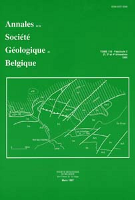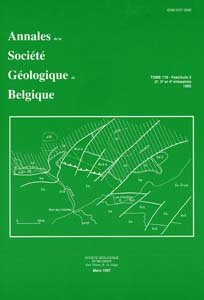- Home
- Volume 115 (1992)
- Fascicule 1
- The stratigraphy of the type locality of the ?Late Wenlock/Early Ludlow Mont Godart Formation and the Early Ludlow Ronquières Formation, Brabant Massif, Belgium
View(s): 581 (10 ULiège)
Download(s): 495 (8 ULiège)
The stratigraphy of the type locality of the ?Late Wenlock/Early Ludlow Mont Godart Formation and the Early Ludlow Ronquières Formation, Brabant Massif, Belgium

Résumé
Dans la vallée de la Sennette à Ronquières, où affleure le Silurien du Massif du Brabant, la Formation du Mont Godart est définie et la Formation de Ronquières, jusqu'à présent mal définie, est redécrite en détail. Sept unités, parfois divisibles en sous-unités, sont distinguées dans cette dernière Formation. Les chitinozoaires et graptolites suggèrent que la Formation du Mont Godart date du Gorstien inférieur (Ludlovien) ou peut-être de l'Homerien supérieur (Wenlockien), tandis que la Formation de Ronquières date du Gorstien (Ludlovien). Quatre faciès sédimentologiques sont présents. Les turbidites argilo-silteuses, interstratifiées entre des hémipélagites laminées anoxiques, prédominent. Plus rares sont les hémipélagites oxiques bioturbées et les métabentonites. Le paléo-environnement du bassin sédimentaire est interprété comme un système de cônes turbiditiques orienté vers l'est, dans une auge est-ouest, à direction apparente des courants vers le nord. Un mégacycle majeur englobe les deux Formations. Des sédiments d'énergie relativement haute, sont présents à la base de la Formation du Mont Godart et au sommet de la Formation de Ronquières. Les couches intercalées à sédiments de plus faible énergie, indiquent un environnement plus profond. Un même cycle de changements de profondeur a été observé au Wenlockien supérieur et Ludlovien inférieur du Pays de Galles et de l'île de Gotland sur la plateforme Baltique.
Abstract
The Silurian of the Brabant Massif crops out in the Sennette valley, near Ronquières. From these outcrops, the Mont Godart Formation is defined and the formerly poorly defined Ronquières Formation is redescribed in detail. Seven informal units, four of them divided into subunits, are distinguished in the Ronquières Formation. Based on Chitinozoa and graptolites, the age of the Mont Godart Formation is estimated possibly latest Homerian (Wenlock) or earliest Gorstian (Ludlow) and that of the Ronquières Formation as Gorstian (Ludlow). Four sedimentological facies occur: mud-grade turbidites predominate and are interbedded in anoxic laminated hemipelagites. Oxic bioturbated hemipelagites and metabentonites occur rarely. The palaeoenvironment of the sedimentary basin is interpreted as a turbiditic fan system directed to the east in a E-W trending trough with apparently northward directed currents. A major megacycle spans both formations. Relatively high energy sediments are present in the bottom of the Mont Godart Formation and in the top of the Ronquières Formation. Less energetic sediments, indicating a deeper sea environment, are found in between. A similar cycle of deepening and shallowing has also been observed in the late Wenlock and early Ludlow of the Welsh Borderland and of Gotland on the Baltic platform.
To cite this article
About: Stephen Louwye
Laboratorium voor Paleontologie, Universiteit Gent, Krijgslaan 281, B-9000 Gent, Belgium.
About: Geert Van Grootel
Laboratorium voor Paleontologie, Universiteit Gent, Krijgslaan 281, B-9000 Gent, Belgium, p.a. Université de Québec, I.N.R.S. Géoressources, rue Einstein 2700, Sainte Foy, C.P. 7500 Québec, GIV 4C7 Canada.
About: Jacques Verniers
Research associate N.F.Sc.R. (Belgium), Vrije Universiteit Brussel (KWAR), Pleinlaan 2, B-1050 Brussel, Belgium.






